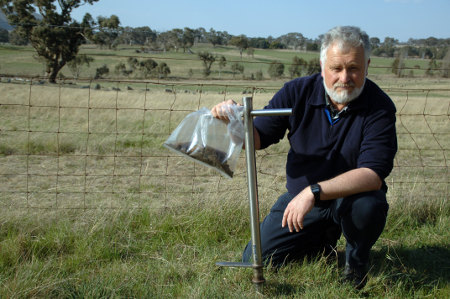
|
Published: 31 October 2011
Phosphorus fertiliser research aims for multiple benefits
New research is focusing on ways of reducing the rising cost of phosphorus fertilizer through improved efficiency in farm application and plant uptake. There are also associated environmental benefits in less over nutrification and fossil fuel use.

|
|
Dr Richard Simpson has been part of a team of CSIRO and other scientists researching the phosphorus efficiency of Australian agricultural soils. Credit:
CSIRO/Carl Davies
|
Phosphorus is central to the high productivity of Australia’s farms, but the price of fertilisers that contain the key element have doubled over the last decade due to rising manufacturing and application costs, and increased demand. High quality phosphorus sources are also finite, another reason for its use to be made as efficient as possible.
Australian and international scientists who conducted a national review of phosphorus application in grazing and cropping systems found that fertiliser use efficiency had good room for improvement. They found that pasture systems had very low phosphorus-use efficiency of 15–30 per cent, while most broadacre grain operations averaged around 50–60 per cent.
Articles from the review, published recently in the journal Plant and Soil, identify some of the major ways to address use the inefficiencies and rising costs. These are: improving fertiliser technologies; applying the right amounts of phosphorus fertilisers at the right times; and breeding plants that can more efficiently take up phosphorous from the soil or grow better in lower-phosphorus soils.
The researchers are now moving ahead with work on these priorities. Dr Richard Simpson from CSIRO’s Sustainable Agriculture Flagship is involved. He says that until now, improvements in using phosphorus efficiently have stalled.
‘Ideally we would like to be applying only one kilogram of phosphorus as fertiliser to produce one kilogram of phosphorus in food and fibre products,’ Dr Simpson says.
‘But for every kilogram of phosphorus that ends up in farm products, usually two to four kilograms of phosphorus has been added to the soil in fertiliser. This is because most Australian soils tend to hold on to phosphorus when they are fertilised and plants can’t access it.
‘If the inefficiency gap can be closed there are big opportunities to maintain high farm productivity with reduced food production costs and reduced phosphorus losses to the environment such as into waterways.
‘The key thing for farmers to think about is whether they are optimising fertiliser application for their production goals. Applying phosphorus amounts that exceed the targets for optimal management simply cost more in fertiliser for no gain.’
Source: CSIRO



